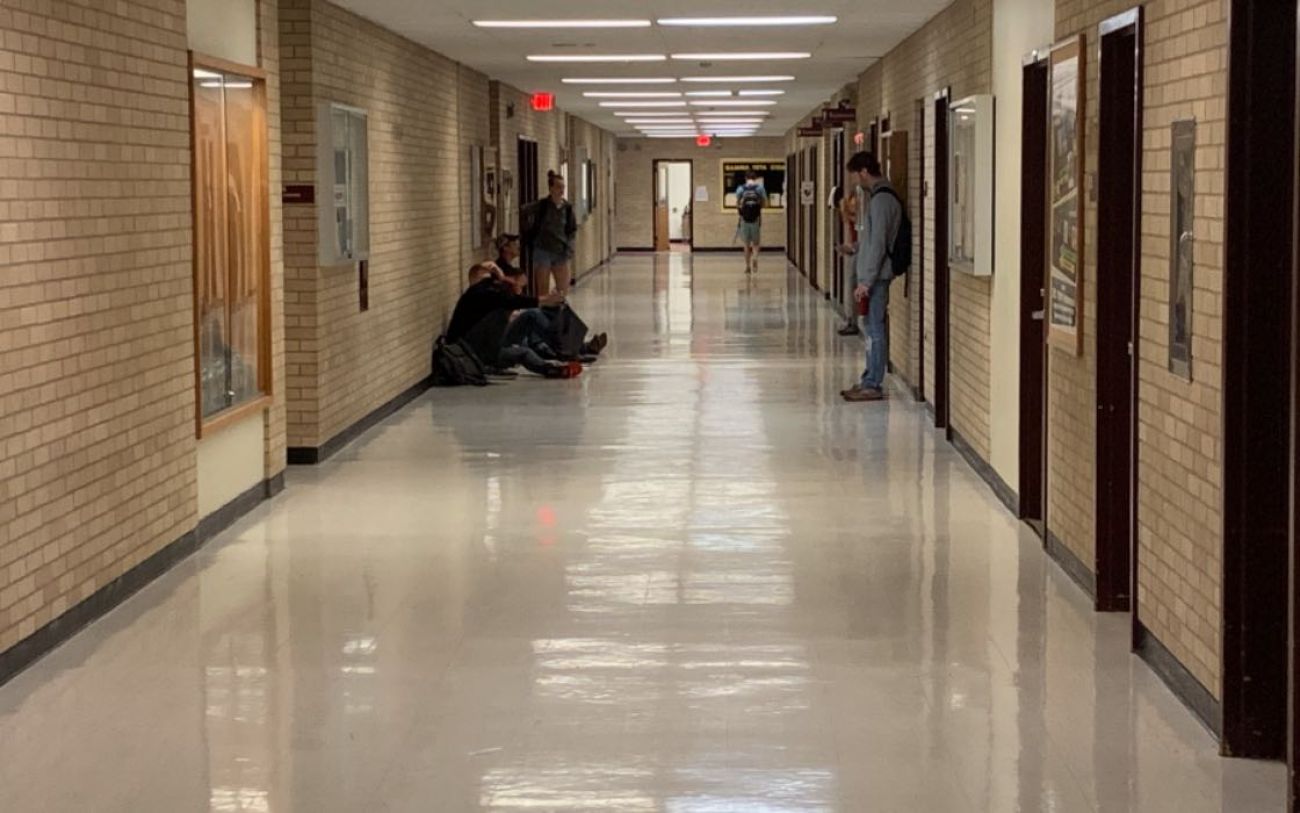Fewer students, tepid state funding roil Michigan public universities

MOUNT PLEASANT—One dormitory is closed this school year and another is operating under capacity. Dozens of degree programs have been shuttered, and classes are increasingly being led by part-time faculty.
From his office in 92-year-old Warriner Hall, Central Michigan University President Bob Davies is fighting wars on two fronts. CMU, which Davies bills as “two hours away from every great spot in Michigan,” is hemorrhaging student enrollment ‒ down 21 percent over the past decade, and almost 18 percent in just the past five years.
The school has lost an average of 1,164 students a year since 2014 – the equivalent of a Chippewa Marching Band parading off campus and never returning three times a year.
CMU has plenty of company. Six of Michigan’s 15 public universities have seen double-digit percentage enrollment drops in the past decade, forcing staff cuts and program eliminations. Only four of the state’s public universities have seen enrollment numbers go up at least 1 percent over 10 years.
Meanwhile, the Michigan GOP-controlled Legislature recently passed a higher education budget, signed by Democratic Gov. Gretchen Whitmer, that gave struggling schools a funding increase so meager that it amounts to a decrease ‒ an average 0.9 percent boost in state money, which is less than the 1.75 percent rate of inflation. Operational funding (money universities have direct control over how it is spent) is up just 0.5 percent.
Wayne State University, for instance, gets a half-percent hike in state funding. The Detroit school, serving 27,000 students, many of whom are minorities and low-income, is slated to receive less money in the 2019-20 budget year than it received in 2010-11, even before adjusting for inflation.
“And these are the good economic times,” said Dan Hurley, CEO of the Michigan Association of State Universities, which represents the state’s public universities. “What happens when there is another recession?”
Michigan universities are facing what amounts to a perfect storm of economic, demographic and political factors. There are fewer Michigan high school graduates in part due to a declining birth rate, leaving colleges to fight over a smaller pool of potential in-state students. That pool is drained more because a vibrant economy is luring some high school grads to go straight into the job market rather than delay earning a paycheck through years of college.
At the same time, there is growing public discontent with higher education, based on rising costs, rising student debt and a belief among some that universities are liberal bastions hostile to conservative thought.
“These factors are real,” Davies wrote in a sobering letter to CMU staffers in February. “They are big. They are not going away.”
Gideon D’assandro, spokesman for House Speaker Lee Chatfield, R-Levering, and Amber McCann, spokeswoman for Senate Majority Leader Mike Shirkey, R-Clarklake, did not return requests for comment on the higher-ed budgets.
Whitmer spokeswoman Tiffany Brown told Bridge the governor “recognizes that a 1 percent increase for public universities and community colleges is not the kind of investment we need to make.”
But she said the governor, in weighing budgets presented by the Legislature, “had to make tough decisions to keep our families and communities safe and to help Michiganders access critical services that they rely on every day.”
- Related: Funding cuts, high tuition spawn a cost crisis at Michigan universities
- Related: EMU prez: tuition is ‘safety valve’ for state budget
The budget Whitmer signed Sept. 30 gives Michigan’s public universities $1.47 billion for the 2019-20 budget year that began Oct. 1. In raw numbers, that’s 3.5 percent more than the 2010-11 appropriation. When adjusted for inflation, however, public university funding from the state has actually decreased 12 percent in nine years.
Before the new budget went into effect, Michigan was 44th in the nation in per-resident support for higher education, at $195.52, compared to a national average of $280.60, according to data compiled by the Center for the Study of Education Policy at Illinois State University and the State Higher Education Executive Officers.
In 2001, Michigan ranked 20th in the nation in per-resident support for higher education. Public college funding dropped soon after that as Michigan entered a one-state recession, and continued to not keep pace with inflation as the economy improved in the past decade.
Lackluster funding and lower enrollment are part of the same vicious economic circle, say experts in higher education economics. As state support goes down or doesn’t keep up with inflation, universities increase tuition to make up the difference in their budgets. That makes college more expensive for high school grads and their families weighing whether to incur four or more years of debt for a degree, or go straight into the job market.
The college-going rate for recent Michigan high school grads was the lowest in a decade in 2018. Just 6 in10 high school grads enrolled in some type of higher education within six months of graduation; the rate was 65 percent as recently as 2015.
“There's no question that there is an impact not only on the university funds, but on communities [where the universities are located],” said CMU’s Davies.
News is far better at the state’s two flagship schools, which grew between 2009 and 2018.
The University of Michigan at Ann Arbor ‒ which accepts about 49 percent of freshmen students from out of state ‒ increased enrollment by 16 percent over this period. Michigan State enrollment rose 6 percent. Also growing were the University of Michigan-Dearborn (12 percent) and Oakland University (5 percent).
The remaining public universities saw student numbers stagnate or decline. CMU dropped 21 percent; Northern Michigan, 19 percent; Wayne State, 12 percent; and Lake Superior State, 14 percent.
So while Michigan and Michigan State continue to break application records, “places that aren’t national names, at those places demographics shape their fortune,” said Brendan Cantwell, associate professor of educational administration at MSU.
Lower enrollment means fewer tuition dollars, but the cost of operating a university doesn’t necessarily go down.
“They’re losing enrollment but their costs don’t change much from year to year,” Cantwell said. “It’s hard for them to change labor costs in the short term because their physical plant stays the same. As revenues decline because the number of students decline, the cost per student increases.”
The result: higher tuition and campus cutbacks, including fewer academic choices for students. At CMU, the number of bachelor degree programs contracted from 121 in 2013-14 to 103 four years later; master’s programs dwindled from 50 to 43.
At Lake Superior State, bachelor degree offerings dropped 27 percent from the 2016 school year to the 2017 school year.
The Carey Hall dormitory at CMU is closed this year to compensate for lower capacity and renovations, according to a student newspaper report on Davies’ remarks at a recent academic senate meeting. (A university spokesperson told Bridge no dorms have been closed because of low enrollment.) At another dorm, some four-person suites now house two or three students.
“Some faculty positions are not being filled and there’s more adjunct (professor) labor,” meaning part-time faculty who generally receive lower pay and benefits, according to Matt Johnson, associate professor of educational leadership and president-elect of the CMU faculty union. “My colleagues in other departments have seen their course [enrollment] caps go from 25 to 35. Class sizes are expanding.”
“At some point, cuts in funding (from declining enrollment and modest state support) aren’t going to be cutting fat but cutting bone,” said MSU’s Cantwell, “and the level of education students have access to is going to decline.”
The implications of fewer Michiganders attending college reach far beyond the state’s 15 university campuses. Fewer college grads typically means lower incomes, the average U.S. adult with a bachelor’s degree earning about $1 million more over their lifetime than someone with a high school diploma.
Michigan ranks 31st in the nation in the share of its population with a bachelor’s degree or higher; the state ranks 33rd in median household income.
The below-average education level of Michigan residents also can hobble efforts to attract businesses to the state. Detroit didn’t make the cut for a new Amazon headquarters in 2018 because of a shortage of talent.
In her first State of the State address as governor in February, Whitmer set a goal of 60 percent of working-age adults with a post high school credential or degree by 2030 to meet the expected demand for a more highly educated workforce. Currently, 44 percent have a post-high school certificate or degree.
Reaching that goal will be difficult in a political environment that sometimes harbors a distrust of higher ed, said Sen Jeff Irwin, D-Ann Arbor, the minority vice chairman on the appropriation subcommittee for universities and community colleges.
“I hear comments publicly and privately about how higher ed is a plot for liberal indoctrination,” Irwin said. “It comes from folks that feel conservative voices are not allowed on college campuses.”
In a recent national Pew poll, 59 percent of Republicans had a negative view of higher education, compared to 18 percent of Democrats. Both parties had positive views of college until 2016.
At a September journalism conference at the University of Michigan, Neal McCluskey, director of the Center for Educational Freedom at the conservative Cato Institute in Washington, D.C., said there are good reasons many Americans have soured on taxpayer-support of higher education.
“People across the board are concerned about the high cost of higher ed,” McCluskey said. “And they combined cost with this feeling that the ivory tower was a citadel of progressivism and hostile to conservatism, and we’ve had enough. Why are we paying for these people who hate us?”
McCluskey argues that Michigan taxpayers should be giving less to public universities, rather than more. Universities could be less palatial and staffed leaner and still offer a good education, he says.
“Look, this is a beautiful campus,” McCluskey said of the University of Michigan. “How necessary is it to have this campus replicated around the state to provide the skills that people need to succeed in the economy? The state would be better off saving their resources for other priorities.”
“Everybody is kind of grumpy with higher education,” counters Cantwell of MSU. “They say, ‘Why does it cost so much? Why is it doing so little?’
“But everyone wants their children to have access to college when the time comes. Those are hard things to square.”
Michigan Education Watch
Michigan Education Watch is made possible by generous financial support from:
Subscribe to Michigan Education Watch
See what new members are saying about why they donated to Bridge Michigan:
- “In order for this information to be accurate and unbiased it must be underwritten by its readers, not by special interests.” - Larry S.
- “Not many other media sources report on the topics Bridge does.” - Susan B.
- “Your journalism is outstanding and rare these days.” - Mark S.
If you want to ensure the future of nonpartisan, nonprofit Michigan journalism, please become a member today. You, too, will be asked why you donated and maybe we'll feature your quote next time!






